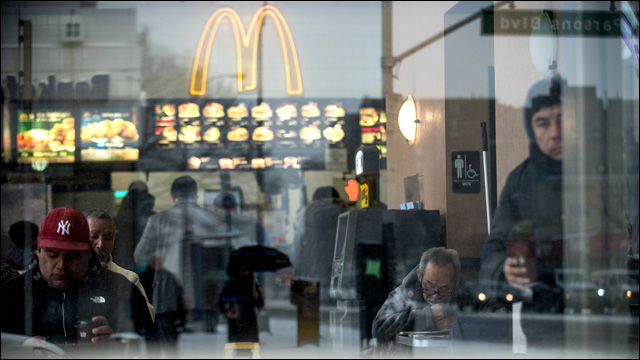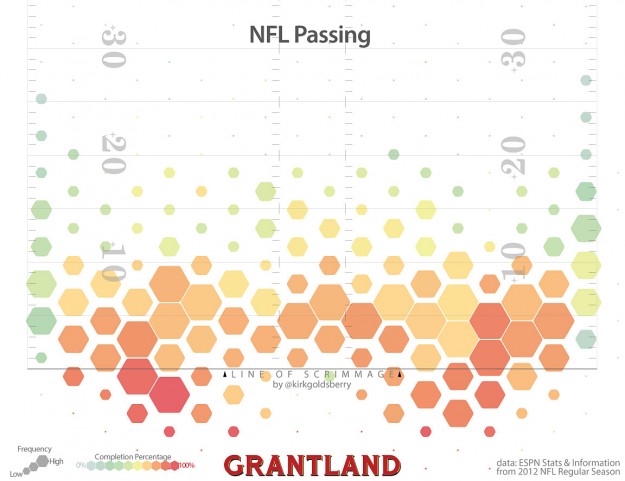Some interesting charts about failed start ups.
Shared posts
How Much Snow It Takes to Cancel School Across the US

There's been quite a bit of debate recently about the Southern states' inability to handle what (at least to the North) might barely even qualify as a light dusting. Now, Reddit user atrubetskoy has taken the opportunity to create a fantastic map detailing just how much snow it typically takes to keep kids home.
Peace brokered between McDonald's and Elderly Koreans

It seems a little silly that a congresswoman and state legislators had to get involved to settle the much-publicized dispute between a McDonald's location in Queens and a group of elderly Korean patrons who refused to leave in a timely fashion. But that's what it took. They've apparently made peace.
Elderly Patrons End Dispute With a McDonald's in Queens
The Flushing fast food restaurant has become a regular gathering place for local Korean seniors who take up seats and stay for hours, much to the management's dismay. The situation has escalated in recent months, and police have actually been called in to remove customers. And now the community has gotten involved.
But it seems they've reached an agreement. Management has agreed to ease the 20-minute seating limit during off-peak hours and post signs stating the policy in Korean and Mandarin. In turn, the seniors will give up their seats during the busy hours if other diners are looking for a place to sit. Boycott averted.
Read more »
Amazing Video Clips Visually Isolate the Flight Paths of Birds


Chances are if you’ve on the internet over the last few years you’ve run into a few amazing bird murmuration videos, like this one from Islands and Rivers or the one we featured on Colossal from Neels Castillion, where countless numbers of starlings flock together and move almost impossibly in concert. Artist Dennis Hlynsky, a professor at the Rhode Island School of Design, wondered what would happen if he could better trace the flight paths of individual birds, what kinds of patterns would emerge from these flying social networks?
Hlynsky first started filming birds in 2005 using a small Flip video recorder, but now uses a Lumix GH2 to record gigabytes of bird footage from locations around Rhode Island. He then edits select clips with After Effects and other tools to create brief visual trails that illustrate the path of each moving bird. Non-moving objects like trees and telephone poles remain stationary, and with the added ambient noise of where he was filming, an amazing balance between abstraction and reality emerges. The birds you see aren’t digitally animated or layered in any way, but are shown just as they’ve flown, creating a sort of temporary time-lapse. Above are three of my favorite videos, but he has many more including the movement of insects, ducks, and other animals.
Shia LaBeouf plagiarizes Dan Clowes for short film
Minimum Wage and the Poverty Line
We really need to raise the minimum wage. As some have pointed out, if a worker can work full time and still not support himself and his family, then the government has to step in with food stamps, housing vouchers, and other big government programs that everyone hates. The low minimum is basically a government subsidy for companies that don’t give a shit about their employees. And contrary to fear mongers, raising the minimum wage does not increase inflation or unemployment.
Polygon's history of the boys-only stereotype for videogames
Tea Lover’s Guide to Los Angeles: Tea Time At Home (Part 1 of 6)
In standard Mandarin Chinese, tea is pronounced “cha” with a dipping tone. However, the common English word “Tea” actually derives from the Taiwanese/Minan/Fujian word for tea. In Taiwanese, I pronounce tea as “deh”, a lot more like “tea” than “cha”, so learning the fact that our English word “tea” is based on my home language pronunciation was a pleasant surprise, giving me a nice unexpected sense of unity between my English-speaking and Taiwanese-speaking selves. That and I’m a tea enthusiast.
Luckily for me, living in LA is like living in a tea wonderland. There are so many options for tea all over the Southland that I thought I’d share some of my tea knowledge in this little 6-part series for those of you looking to enjoy Los Angeles from a tea lover’s perspective.
The photo above is from a potluck tea party I had with friends a few years ago. A lovely tea time at home is a piece of cake, literally. I don’t cook or bake, but there is such a variety of bakeries here that it’s so easy to have a wonderful afternoon tea at home any day of the week, especially with our almost endless days of sunshine.
Here are some great places I frequent for cakes and desserts to go with my tea:
Susina Bakery & Cafe – European American baked fare
Urth Caffe - California fusion
Yamazaki Bakery – Japanese fusion
J.J. Bakery – Taiwanese fusion
85C Bakery Cafe – Taiwanese fusion
Nini Bakery – Taiwanese fusion
Phoenix Food Boutique – Asian fusion
Aside from top grade tea my parents or friends pick up for me on trips to Asia, I purchase most of my loose leaf teas from Bird Pick or Wing Hop Fung, both of which are basically different versions of the same store. If you do see a bag of their instant ginseng honey tea packets, pick one up for sure because this quick hot sweet drink is like a magic healing potion when you’re feeling under the weather. In this next photo, you’ll see that I sometimes splurge on my loose leaf teas.
Another cool source of high quality tea is Teavana, which most people can find in a local mall. They often boast a selection of 100 teas, but that’s still not as many as what’s available at Bird Pick/Wing Hop Fung.
Next up, Part 2: Tea Station.
Apple and Samsung Combine to Take 109 Percent of Handset Industry Profits
Neil Hughes, writing for AppleInsider:
The latest data from Canaccord Genuity, shared with AppleInsider by analyst T. Michael Walkley on Thursday, estimates that Apple took 56 percent of the operating profits for feature phones and smartphones in the third quarter of calendar 2013. Coming in close second was Samsung, which took 53 percent of industry profits.
In contrast, all of the competition lost money, with the exception of Sony, which broke even during the quarter.
American microclimates of exclusivity
Writing in the Times, Frank Bruni notes the increasing tendency in the US to provide various levels of service for money.
Much has been made of commercial flights these days, with all those divisions between first class and coach. For various supplements or with various deals, you can get a few more inches of legroom or, shy of that, a prime aisle seat. You can get to board earlier or later, and thus hoard or miss out on the overhead bins. Will it be long before there's a ranked queue for the bathroom? I'm not even sure I'm kidding.
It's not that pecking orders or badges of affluence are anything new. Our homes, cars, clubs and clothes have long been advertisements of our economic clout, used and perceived that way.
But lately, the places and ways in which Americans are economically segregated and stratified have multiplied, with microclimates of exclusivity popping up everywhere. The plane mirrors the sports arena, the theater, the gym. Is it any wonder that class tensions simmer? In a country of rising income inequality and an economy that's moved from manufacturing to services, one thing we definitely make in abundance is distinctions.
Reminds me of Tom Junod's piece in Esquire about waiting in line as an expression of American democracy.
Tags: Frank Bruni Tom Junod USAApparently, an Englishman named Leonard Sim took his family to Disneyland a few years ago, and his vacation was ruined by waiting in line. He invented something called the Flash Pass, and then sold it to an English company called Lo-Q -- as in "Low Queue" -- which contracted it to Whitewater. So now, when you go to Whitewater and many other American amusement parks, you pay for parking ($15, at Whitewater), and then for admission ($37.50, for any human being over 48 inches tall), and finally for a locker ($16), and then, once you're inside, you can pay an extra $30 for a "standard" Flash Pass or $40 for the "gold." And then you can cut the lines.
It sounds like an innovative answer to the problem that everybody faces at an amusement park, and one perfectly in keeping with the approaches currently in place at airports and even on some crowded American highways -- perfectly in keeping with the two-tiering of America. You can pay for one level of access, or you can pay for another. If you have the means, you can even pay for freedom. There's only one problem: Cutting the line is cheating, and everyone knows it. Children know it most acutely, know it in their bones, and so when they've been waiting on a line for a half-hour and a family sporting yellow plastic Flash Passes on their wrists walks up and steps in front of them, they can't help asking why that family has been permitted the privilege of perpetrating what looks like an obvious injustice. And then you have to explain not just that they paid for it but that you haven't paid enough -- that the $100 or so that you've ponied up was just enough to teach your children that they are second- or third-class citizens.
Plants vs. Zombies 2: Between Scylla and Charybdis

The following two articles form an interesting diptych on Plants vs. Zombies 2:
- Owen Faraday slams the game because it “it exists primarily to wheedle you for money”
- Michail Katkoff argues the opposite, describing it as “pretty much a paid game without the price tag”
In other words, the first author believes that the game is ruined by microtransactions while the second author believes that EA didn’t do nearly enough because it was “afraid to upset players.” Did EA ruin PvZ2 by going free-to-play? Or did it simply not go far enough? These two pieces seem to emerge from parallel dimensions.
Indeed, the two writers are from very different worlds. Faraday is the founder of Pocket Tactics, the premier mobile strategy game blog. As it caters to core gamers, free-to-play is generally considered a dirty word there. Katkoff, in contrast, was a Product Manager for Supercell’s cash-cow free-to-play strategy MMO Clash of Clans, a game notorious for attracting whales willing to drop thousands of dollars on the game.
For Katkoff, PvZ2 represents great unfulfilled potential as a free-to-play game because EA did not aggressively tempt players enough to spend. For one thing, the game is not hard enough to force players to buy boosters:
Sadly PvZ2 is ridiculously easy. It takes absolutely no effort to pass levels, making the game unchallenging and boring. . . . PvZ2 offers boosters for real currency, which enable players to clear levels with some consumable super powers. But to create the demand for these boosters players need to have those moments where they’re just about to clear a level and realize that they’ll lose without the help of a booster. Lack of challenge results in low demand for boosters, which causes stagnant revenue.
Furthermore, the game lacks the gates that typically restrict players in free-to-play environments, which then creates demand for various unlocks and powers:
PvZ2 has no restriction mechanics and thus no core loop. An ideal core loop for the game would have been similar to the one in Candy Crush Saga, where sessions are restricted with energy mechanics. I’d argue that energy-based core loops would have increased monetization of the game by creating consistent demand for energy and increasing demand for power ups – when level restarts have a cost, not failing a level becomes valuable.
EA created plenty of ways to spend money - plant unlocks, special powers, extra plant food, and so on - but the game is not engineered to push players to spend. Hence, the game quickly dropped out of the top 20 in the Top Grossing list for iOS games and now hovers around number 50, which Katkoff considers a failure for a game with such high promotion and anticipation.
In contrast, the game simply disgusts Faraday; the experience is ruined because commerce becomes a constant and unwelcome guest, poisoning the atmosphere and taking the focus away from pleasing the player:
Plants vs. Zombies 2 is designed to be fun, of course, but it’s very obviously designed to be just fun enough that the frustration of playing it will force you to open up your wallet to buy an early unlock of a plant for $5, or spend $6 to see a new part of the game world. It’s crass. It’s gauche.
After praising the charm and originality of the original, Faraday declares that “the biggest mistake EA and PopCap could have made with Plants vs Zombies 2 would have been to make it a slow, grindy treadmill.” Unfortunately, to extend the gameplay and create room for an in-game store, EA did just that:
After the first eleven levels, PvZ2 grabs the treadmill’s speed control and slams it all the way back. Once you’ve finished the 11th level in Egypt and seen everything that that game world has to offer, Plants vs Zombies 2 informs you that to progress to the next world, you have to go play all of the levels over (and over) again, gaining stars to unlock the pirates. Or you can just pay six bucks.
In some ways, the two authors seem to differ factually (the star system Faraday describes does sound a bit like the type of core loop, with built-in gates restricting the player, that Katkoff recommends). Nonetheless, that both Faraday and Katkoff view PvZ2 as a failure is damning for EA; if they couldn’t please either the free-to-play money guy or the original fan of the series, then who were they trying to please? Perhaps the ugly lesson here is that if a company decides to risk losing its core audience, then it might as well go all the way and make sure it gets the money.
EA is caught between the Scylla of core gamers and the Charybdis of whales. Core gamers care about what they play, and for decades, they made EA a very wealthy company. Unfortunately, whales are going to make other companies even wealthier. They turned Supercell into a $3 billion company from just two free-to-play games, which now generate over $2.5 million per day at an insane 75% profit margin. By comparison, EA had an anemic 2.5% profit margin last year, and they made a lot more than two games. As a public company, how can EA ignore whales and compete with companies like Supercell which cater to them? The answer is that they can't, and Popcap won’t be making games like the original Plants vs. Zombies anymore.
Apple Factories in America: Plenty of East Asians in Tech, but Few in Upper Management
by Leeland Lee
After its recent I.P.O. filing, Twitter provoked an outcry over the lack of women among its board of directors and senior management. Time Magazine declared that “Twitter’s all-male board spells failure,” while The New York Times pointed out that Twitter inadvertently exposed a more general problem—the lack of diversity in male-dominated board rooms in Silicon Valley.
Just how lopsided is the ratio of male-to-female leaders among the top software companies? A recent examination of various company profiles revealed that, not unexpectedly, women are indeed a rare species in upper management. But compared to women, the number of leaders of East Asian descent is even rarer—and by a wide margin. So where’s the outrage?
Among the trendiest tech companies in the Bay Area—Google, Apple, Facebook, Ebay, Yahoo, Twitter, LinkedIn, Hewlett-Packard and, for good measure, Microsoft and Amazon thrown in—only roughly 1% of upper management and 2% of board members are East Asian. In contrast, women populate about 18% and 19% of these positions, respectively.
And who are the privileged minority who hold these positions of power? At Microsoft, Qi Lu is an Executive Vice President. Andrea Jung, former CEO of Avon, serves as a member of Apple’s board of directors. David Sze sits on the board of LinkedIn. And that’s it. Out of a total of 196 leadership positions, just 3 are occupied by individuals of East Asian heritage.
To be fair, South Asians, predominantly of Indian descent, can be found among the top brass at Google, H-P, Twitter and LinkedIn. On the other hand, Facebook does not count Asians of any sort on its masthead. Yahoo, co-founded by Jerry Yang, currently has none. Neither do Ebay and Amazon. That’s 0 out of a total of 87 upper management positions.
If the lack of females among the upper echelons of Silicon Valley can provoke such a firestorm of criticism, the far greater absence of East Asians should be especially laughable, if it weren’t grounds for disgust. Part of the reason why men outnumber women in tech leadership is at least partially attributable to the overall under-representation of women in engineering and computer sciences. “The tech industry has an image problem … that repels girls,” writes Claire Cain Miller in the Times. “Think geeky man alone at a computer.”
Is this geeky man Asian? Needless to say, the absence of East Asian leaders is likely not due to a shortage of Asians who obsess over their computers and assorted gadgetry et al.
Indeed, this sentiment has recently been borne out by Census Bureau studies published last year by the San Jose Mercury News, also known as “The Least Surprising Study Ever”: Asians now constitute a majority of workers in the Silicon Valley tech industry. Even for those who don’t work in tech, this dramatic demographic shift is readily apparent, from the rise of all-Asian enclaves in the Bay Area, to the all-Asian strip malls that now languidly dot the crowded freeways.
East Asians are everywhere in the Bay Area, it seems, except in the board room.
As the Mercury News pointed out, a good number of Asian workers are now imported from overseas. Thus, we might assume these individuals likely lack the requisite language skills to rise to upper management. But still. What happened to all the East Asian computer science graduates from Berkeley and Stanford? What became of them?
I know some of these people, and what became of them is that they got rich. Many joined and became essential cogs in the above-mentioned companies. Over the years, they purchased homes in Palo Alto, mansions in Belmont, started families complete with 2.5 over-achieving tots. You might even say, they became successful.
Which makes the absence of East Asians among Silicon Valley leadership even more frustrating. Can a culture really be considered successful if its members reach the elite 1% , but settle for a life of behind-the-scenes anonymity? How does one judge a person who spends all day essentially pushing buttons, but never the buttons of power? Does wealth bring happiness but also attract the cloud of complacency?
Over the past couple years, the egregious human rights abuses by Apple factories in China have been well-documented. Here in Cupertino, the workers may be better compensated and the work less physical, but until East Asians reach the upper echelons of management in larger numbers, they will continue to toil, more or less, in what are essentially still Apple factories.
ABOUT THE AUTHOR: Leeland Lee has previously written for 8Asians.com about the portrayal of Lieutenant Sulu in the most recent Star Trek film
The Geography of Pizza
Nearest pizza parlor chain within a 10 mile radius:
Individually:
But there are other important pizza questions. How much of pizza sales do the chains represent?
How do the sales breakdown?
Who has the most pizza stores? NYC! Oddly, though, Miami has the most per capita.
p.s. – I love pizza. The best pizza in the world is Pontillos.
Most popular girl names by state
Reuben Fischer-Baum looks at the most popular girl names by state, over the past six decades.
Baby naming generally follows a consistent cycle: A name springs up in some region of the U.S.—"Ashley" in the South, "Emily" in the Northeast—sweeps over the country, and falls out of favor nearly as quickly. The big exception to these baby booms and busts is "Jennifer", which absolutely dominates America for a decade-and-a-half. If you're named Jennifer and you were born between 1970 and 1984, don't worry! I'm sure you have a totally cool, unique middle name.
Like the trendy names and unisex names explorations, this series of maps is based on data from the Social Security Administration, which is surprisingly formatted and ready to use. If you're looking to play around with time series data and simple state geography, the SSA site is worth a bookmark. [Thanks, John]
'Calvin & Hobbes' creator: 'I don’t think comics have ever been more widely accepted'

Calvin & Hobbes creator Bill Watterson rarely gives interviews, but this month he sat down with Mental Floss for a long interview about his work and his life after Calvin. As in previous interviews, Watterson maintains there are no new comics in the pipeline. He says Calvin's rush of success "created a level of attention and expectation that I don't know how to process," and he has no interest in repeating the experience. At the same time, Watterson sympathizes with the clamor for more Calvin. "You can’t really blame people for preferring more of what they already know and like," Watterson says. "The trade-off, of course, is that predictability is boring. Repetition is the death of magic."
Absurd Portraits from the National Beard & Mustache Championships by Greg Anderson










This outrageous display of facial hair configurations made an appearance at the 4th Annual National Beard and Mustache Championships in New Orleans earlier this month. Luckily Las Vegas-based photographer Greg Anderson was on-hand to give us a front-row seat as the bizarre spectacle of facial hair paraded in front of his camera lens. The championships involved some 150 contestants from the U.S., U.K., and Canada who competed in 17 different categories. If this isn’t enough, here’s a giant gallery of 164 portraits from the event. (via PetaPixel, Twisted Sifter)
Anil Dash's Meeting with Pax Dickinson, online asshole
Where NFL quarterbacks throw
Kirk Goldsberry, known for his basketball analysis and shot charts, has applied his talents to football passes relative to the line of scrimmage. (Football, a.k.a the sport that I might as well watch until basketball starts again.)
More than 68 percent of the league’s passes are short throws that target receivers either behind the line of scrimmage or within 10 yards of it. Some may find it surprising that many of the league’s passes target players behind the line of scrimmage. But screen passes and checkdowns are relatively common. Regardless, the most common throws by far are those short positive-yardage attempts.
I sense player-by-player pass maps in the works.
Dreamy Architectural Watercolors by Sunga Park

Paris, France

Oxford, UK

Oxford, UK

The Whitehall street entrance, London

Dongseo elevated highway, Busan

Harrods, London

Sacre-Coeur church in Montmartre, Paris
These architectural watercolor studies by Sunga Park seem to drip and fade out of focus like a memory or a dream. The graphic designer and illustrator currently lives and works in Busan, South Korea as a wallpaper designer but it seems her true passion is for watercolor and other artistic endeavors. See much more of her work on Behance and Flickr. If you liked this, also check out the work of Maja Wronska.
The Earth’s Seasonal “Heartbeat” as Seen from Space

We all know that as the seasons change on Earth, temperatures rise and fall, plants grow or die, ice forms or melts away. Perhaps nobody is more aware of this than NASA’s Visible Earth team who provide a vast catalog of images of our home planet as seen from space. Last month designer, cartographer, and dataviz expert John Nelson download a sequence of twelve cloud-free satellite imagery mosaics of Earth, one from each month, and then created a number of vivid animated gifs showing the seasonal changes in vegetation and land ice around the world.
Despite having encountered numerous seasonal timelapse videos shot here on Earth, this is the first time I’ve ever seen anything like this visualized on such a large scale from space. It really looks like a heartbeat or the action of breathing. Read more over on Nelson’s blog, or see a much larger version of the gif here. (via Co.Design)
Behold, The World's Biggest Cup of Boba

It was a momentous night. On Saturday, at the 626 Night Market in Arcadia, California, event organizers unveiled a crowning achievement in Asian beverage history: The World's Largest Boba Cup.
Standing 6 feet tall (almost 10 feet if you also count the giant straw) and made of plexiglass, the cup holds 320 gallons of tea -- that's over 2,500 cups of a standard 16 oz. boba drink. My only question: did they have giant tapioca balls to go inside the giant cup of milk tea? More photos here.
626 Night Market is the largest Asian night market in the United States, featuring over 160 food and merchandise vendors, entertainment and other activities. The next event will be on Labor Day weekend, August 31 and September 1, in Santa Anita Park. For more information, visit the 626 Night Market website.
The Passage of Time Captured in Layered Landscape Collages by Fong Qi Wei







Time can be a difficult variable to visually convey in still photography, both the length of time an exposure takes or a series of photos meant to depict the passage of time can be somewhat ambiguous without a written explanation. In his latest series, Time is a dimension, Singapore-based photographer Fong Qi Wei (previously) explores just that idea by shooting landscapes from a stationary position over a 2-4 hour period and then digitally slicing the images to create a layered collage. He shoots at sunset or sunrise to obtain a wide variation in light and then carefully cuts each image to reveal incremental timeframes. He explains:
The basic structure of a landscape is present in every piece. But each panel or concentric layer shows a different slice of time, which is related to the adjacent panel/layer. The transition from daytime to night is gradual and noticeable in every piece, but would not be something you expect to see in a still image.
Similarly, our experience of a scene is more than a snapshot. We often remember a sequence of events rather than a still frame full of details. In this series, I strive to capture both details and also a sequence of time in a single 2 dimensional canvas. I hope it gives you pause and reconsider what you experience versus what you shoot with your next camera phone.
You can see many more examples on his website, and read more about his process right here.
Dammit. The whitewashed Akira remake is back on.

Aggghhh. Sorry, Akira fans. Warner Brothers still seems hell-bent on making this live-action Akira adaptation thing happen, despite the fact that every fan of the original manga and movie seems to think it's an awful idea. Jaume Collet-Serra is reportedly in discussion to direct: Jaume Collet-Serra Returns to Direct 'Akira.'
Collet-Serra was going full-steam ahead with his whitewashed adaptation of the beloved Japanese classic, before production was stalled in early 2012. This version was going to star a mostly-white cast and transplanted the story's post-apocalyptic Japanese setting to "New Manhattan." So yes, hardcore fans breathed a sigh of relief when the project hit the brakes.
But dammit, it looks like the studio is not letting this go:
Read more »
Can we just all agree to stop using "chink in the armor"?

Aw man. Come on. All right, so you may have heard that News Corp/21st Century Fox CEO Rupert Murdoch is splitting with his wife of fourteen years, Wendi Deng. This is not news I give a crap about, but...
This week, during a segment of CNBC's Power Lunch, Robert Frank used the phrase "chink in the armor" to describe Deng and Murdoch's pending divorce. This did not sit well with the Asian American Journalists Association: CNBC Reporter's Use of "Chink in the Armor" Condemned By Asian American Journalists.
Okay, I understand that this is a legitimate phrase. And I can recognize when it's being used innocently enough... But of all the things you could say to express these particular ideas, and all the words you could use in this situation, "chink in the armor" is simply a really bad choice. Here's video of the broadcast:
Read more »
Suddenly, I was rage-reading millennial trend pieces every day.
Hell yeah "Asians Eat Weird Things": An Ode to Asian Food by The Fung Brothers & AJ Rafael

Do you like Asian food? The Fung Brothers love Asian food in all shapes, sizes and smells -- no matter how weird. They love it so much, the comedic rap duo partnered with singer/songwriter AJ Rafael and the premier supermarket chain 99 Ranch to make this funny, epic music video, "Asians Eat Weird Things." Damn right, Asians eat weird things -- and they're not ashamed:
Read more »















